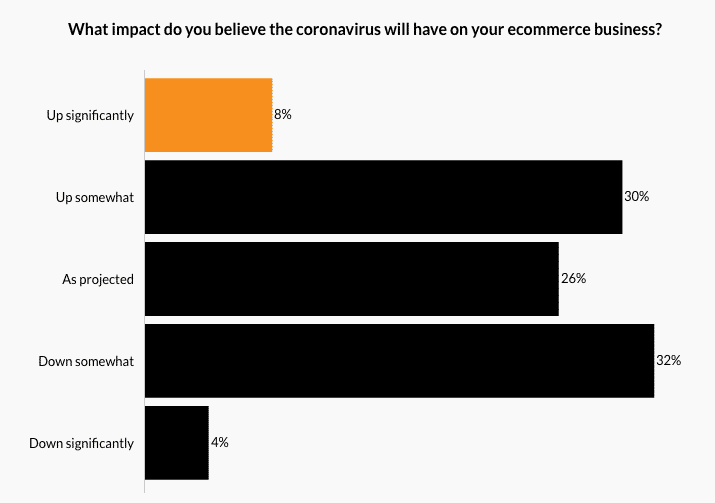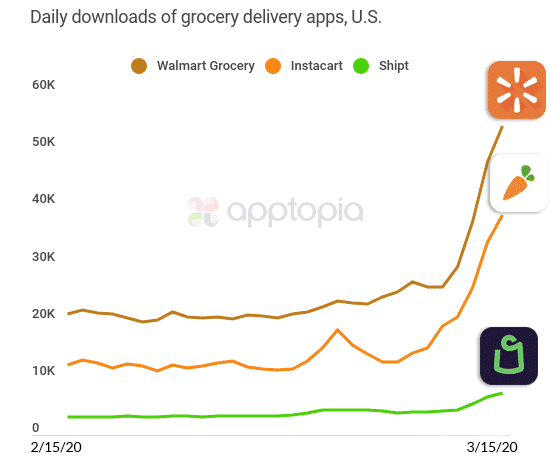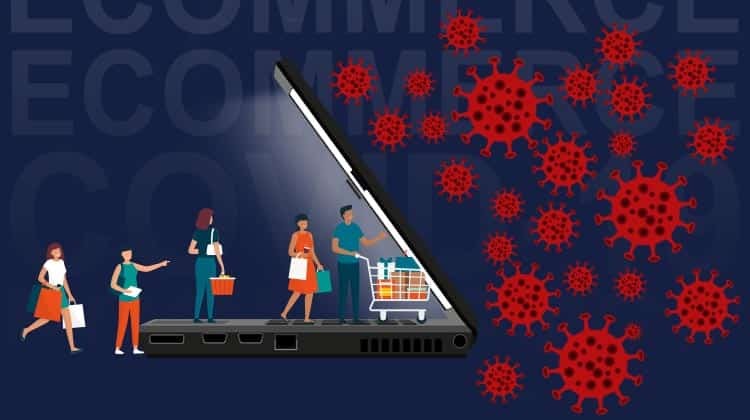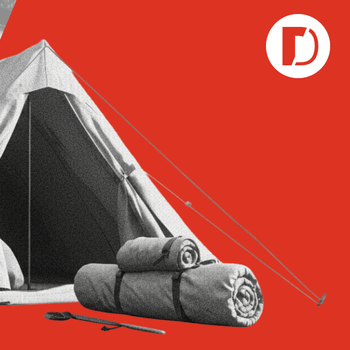How to Adapt Your Ecommerce Strategy to the Challenges of COVID-19
by Aden Andrus • March 24, 2020
COVID-19 has put ecommerce businesses in a bit of an interesting position.
On the one hand, internet usage has spiked by up to 50% as people turn to the internet to help them deal with the demands of social distancing. On the other, millions of people are in danger of losing their jobs of having their hours cut back, so ecommerce conversion rates are already down 14%.
In other words, your audience is online…but they’re hesitant to buy.
To make things even more difficult, the novel Coronavirus has had a big impact on manufacturing, production and shipping. Many ecommerce businesses have little-to-no product to sell, and those that have product in stock or on its way have to deal with extended shipping times.
So, between tight-fisted customers and product shortages, is it time to give up? Should you just hunker down and hope to wait out the storm? Or are there still opportunities to be had in the midst of this global crisis?
Ecommerce and COVID-19
Whether your business is strictly online or ecommerce is a supplement to your physical location(s), COVID-19 will affect you in one way or another. Even if your core product offering is largely unaffected by Coronavirus concerns, the economic fallout will have an effect on your customer base.
Is it any wonder, then, that 36% of retailers believe that COVID-19 will have a negative impact on their business?

Image Source: Digital Commerce 360.
Even major retailers are adjusting their strategy in response to the Coronavirus. Amazon is currently not accepting shipments of non-essential items to its warehouses—effectively shutting down the majority of its Fulfilled by Amazon sellers.
In addition, Amazon seems to have turned off most of their paid search ads, choosing to focus their marketing efforts on—again—essential items like baby products, health and personal care products, groceries, and pet supplies.
However, Amazon isn’t trying to hold out and survive COVID-19. Far from it, in fact. These moves are part of a broader strategy. Between hiring 100,000 new employees and investing heavily into essential and non-essential items alike, Amazon seems to be actively trying to take advantage of this unique situation to build its market share.
Clearly, Amazon and other large retailers see this situation as a big opportunity. You may not have the purchasing power of a mega-corporation like Amazon or Wal-Mart, but if you handle things the right way, COVID-19 can be a big opportunity for your business, too.
A Whole New World (of Ecommerce)
To be honest, while Coronavirus has created a lot of challenges for retailers, this situation has a ton of positive long-term potential for ecommerce as a whole. People are being forced to learn how to shop online for new things and in new ways. No matter what the future holds, this pandemic will change how people view ecommerce forever.
Despite the widespread growth of online shopping, the vast majority of retail spend still takes place offline. While you can buy almost anything online these days, many people still treat ecommerce like a digital catalog. They’ll shop online for unique or specific items that are hard to find elsewhere, but they buy everything else from brick-and-mortar stores.
For example, many people still want to see and touch their groceries (especially produce) before checking out. Now, however, visiting the grocery store is a walk on the wild side. You might find what you need, you might have to check out several stores…and you just might catch Coronavirus while you’re at it.
As a result, online grocery sales have exploded. Downloads of Instacart, the Walmart Grocery app and Shipt have increased 218%, 160%, and 124% compared with a year ago.

Image Source: Apptopia.
People are being forced to adapt or—quite possibly—die. Given the nature of the Coronavirus, even technology-resistant groups like the 60+ demographic are beginning to explore their ecommerce options.
This sort of learning and discovery will have long-term effects on how people shop. Ecommerce has always offered a ton of convenience and options, and more people than ever are finding out just how nice online shopping can be.
Seizing the Moment
So, how do you make the most of this situation? How do you use this shift in customer perspective to grow your ecommerce business? How do you push your business forward amid product shortages, shipping delays and economic uncertainty?
We don’t claim to have all of the answers, but if there is anything to learn from Amazon’s moves over the past few weeks, it’s that now is the time to be aggressive.
The simple fact of the matter is that times are changing. Like your customers, if you don’t adapt, your business could die. It might not die today, but if you don’t take advantage of the coming months, it won’t be long before your company starts to struggle.
Dealing with High Supply and Low Demand
If you’ve got product, but no one is buying, you’ve got two options: change your messaging or sit tight. The right choice will depend on your business.
If your business sells non-essential items like expensive watches or handbags, you may just want to hunker down. You’re selling a “want”, not a “need”. When the future is financially uncertain, people are more careful about how they spend money, so it can be hard to get them to splurge on a “want”.
After all, who knows if they’ll need that money later?
However, that doesn’t mean you can’t successfully advertise this kind of product right now. You’ll just have to adjust your strategy a bit.
There are a variety of ways to encourage people to buy something they want—even when the future is in doubt. For instance, people are well aware that many businesses are struggling as a result of COVID-19. Offering a significant discount to “help you keep the doors open” can play to this sentiment.
If the deal is good enough, people will buy simply out of fear of missing out. This sort of tactic is particularly well-suited to remarketing campaigns, since you’ll be targeting people who already have an interest in your products.
Alternatively, you can try creating a bundle or even offering essentials like toilet paper as a free gift with a purchase. Or, flip things around and sell the toilet paper for the going price of your product and make your product free, like this business:

If discounts don’t fit your brand, you can use the stress people are feeling to encourage people to pamper themselves. People love to self-indulge when they feel overwhelmed, so a smart “Take care of yourself” or “You deserve something nice”-style campaign may be a great way to boost your struggling sales.
Handling High Demand and Low Supply
If you’re dealing with product shortages, you have a very different problem. Unfortunately, you can’t market product that you don’t have—especially if you’re selling high-demand essentials that people need now.
If demand is high but the immediacy of the need is low—say, you’re selling food storage or other preparedness items—this is a great time to try and build a backorder list.
Of course, the feasibility of this approach will depend on your business and product, but if your company can handle it, a “Sign up now before our list fills up” type of ad can be a great way to take advantage of the urgency people are feeling right now.
If your business can’t meet current demand and you’re waiting for stock to arrive, it may feel like there isn’t much you can do right now. However, this down-time is actually an incredible opportunity. Instead of sitting on your hands, you can use this waiting period to gear up for the future.
Often, as marketers, we have a running list of things that we need to fix, tweak or improve that we never seem to get to. This is your chance to get on top of those things and adapt to how ecommerce is changing.
Here are a few ideas to get you started:
- Assess your social media ad campaigns
- Update your product descriptions
- Review and revise your Google Shopping campaigns
- Rebuild/rebrand your website
- Bulk out your retargeting strategy
- Brainstorm A/B tests for your ads and set up the tests
- Take a look at your analytics (on both your site and your ad platforms) and identify ways to improve your campaigns
- Write and refine a video ad script
- Take a few steps back and look at the big picture for your marketing
- Organize your marketing assets
- Plan and fill out your social media calendar
- Ask someone (or some agency) to audit your ad accounts and implement their suggestions
Ideally, you should emerge from the next few weeks ready to take your online marketing to the next level. Ecommerce can be pretty hectic, and it’s rare to get the chance to really dial into your marketing strategy. This is a fantastic opportunity, so don’t waste it!
The Sweet Spot
If you don’t find yourself in either of these situations, count yourself lucky. You’re actually well-situated to take advantage of this crisis—especially when it comes to paid social advertising.
On Facebook and other paid social platforms, you’re competing with all kinds of different businesses for a spot on your audience’s radar. Many of those businesses are dialing back their ad spend because they don’t have the ability to fulfill orders, giving you a great opportunity to step in and snag cheaper clicks.
For businesses in this sort of situation, now is the time to double down on your online advertising. Your target market is bored and looking for things to do online, so it’s the perfect time to get in front of them.
To make things even better, they’re also stressed out. If you can show them how to make life a little less stressful by buying your product(s), there’s a good chance that they’ll jump at the opportunity.
In all of these different situations, there are challenges and opportunities to be had. All you have to do is figure out how to seize the moment and make the most of your situation.
Conclusion
Thanks to COVID-19, the world of ecommerce is changing. Some of those changes are good, and some are real challenges.
For many businesses, the difference between success and failure in the coming months will be how they choose to respond to these changes. Will you sit back, cross your fingers and hope for the best? Or will you be aggressive, find ways to adapt to this constantly changing situation and discover new ways to grow?
In the end, the answer is up to you, but if you’d like our team of experts to help you find effective ways to market in these challenging times, let us know here or in the comments. We’d love to help!
How do you think COVID-19 will affect ecommerce businesses? Do you agree with our thoughts and recommendations? Leave your thoughts in the comments below.





